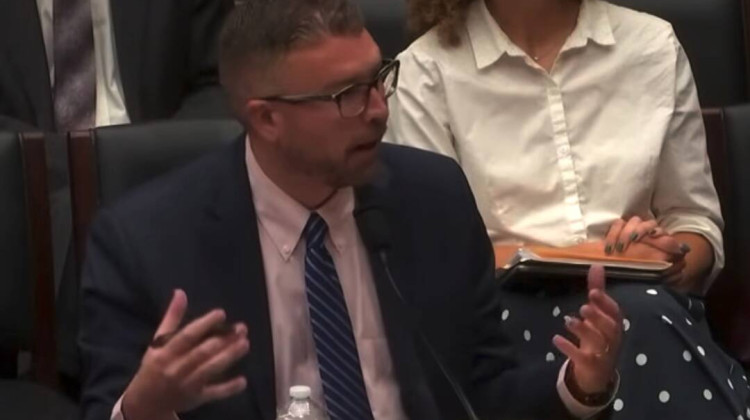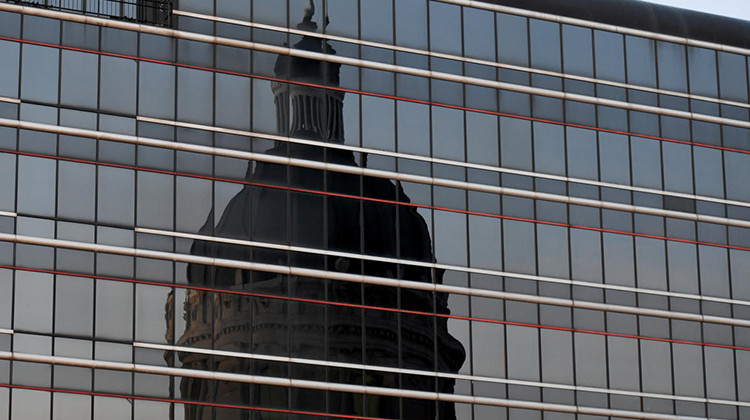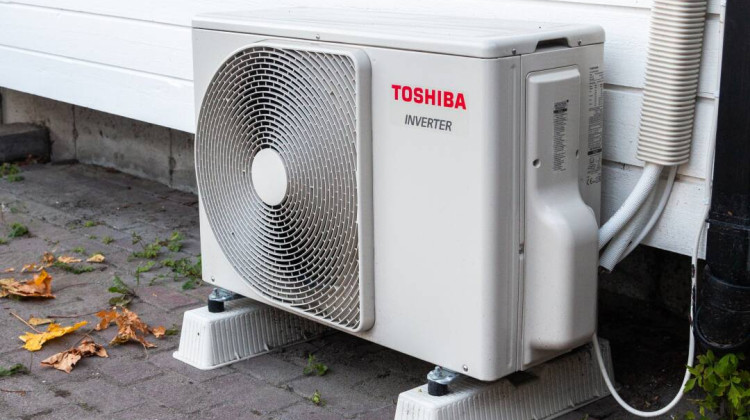
IDEM Commissioner Clint Woods spoke at a recent hearing about the Clean Air Act at the U.S. House Committee on Energy and Commerce.
Courtesy of the U.S. House Committee on Energy and CommerceThe head of the Indiana Department of Environmental Management said the Clean Air Act — the federal law that regulates air pollution in the U.S. — desperately needs to be updated. Clint Woods spoke at a recent hearing about the Clean Air Act at the U.S. House Committee on Energy and Commerce.
The last major update to the Clean Air Act was 35 years ago. Though rules that come out of the act are updated more frequently — like the National Ambient Air Quality Standards, which are updated about every five years.
On the new limits for soot
Woods said the federal government should repeal the Biden administration's standard for soot — pollution that can harm your heart and lungs that often comes from things like cars, factories and coal plants.
The Environmental Protection Agency under former President Joe Biden lowered the amount of soot allowed from 12 micrograms per cubic meter to 9 micrograms. Woods said while most of Indiana is expected to meet the stricter standard, it's doesn't leave much "headroom."
"It really limits the ability of new investment to come in — whether that's a data center new energy generation opportunity for advanced manufacturing. And so, that really is a limiting factor in a state like ours," Woods said.
Woods called the standard "legally and scientifically dubious" but didn't explain why. Like most EPA rules, industry had the opportunity to weigh-in on the new soot standard.
READ MORE: EPA rule to limit soot could save lives, especially in Indiana's metro areas
Janet McCabe served as the deputy EPA administrator under Biden. She is a visiting professor with the Indiana University McKinney School of Law and affiliated with IU's Environmental Resilience Institute.
She said the National Ambient Air Quality Standards — like the one for soot — are one of the biggest decisions that the EPA takes on.
"It is highly documented and supported. And I actually think that of all the pollutants out there, there is the most agreement around particulate matter," McCabe said. "The science shows that there is no threshold below which it is safe to breathe in particulate matter. The risk gets less and less as you get lower and lower. But the in terms of lives saved and health improved, when you lower that standard, you are protecting public health. So I really would wonder about statements that question the how well that decision was supported."
The new standard is expected to save thousands of lives in the U.S. every year — including in Indiana's metro areas.
On EPA's review of state decisions
Woods said the EPA often "second-guesses" Indiana's decisions — like its plans for implementing federal air quality standards and the permits it grants for facilities that pollute. He said this causes delays, threatening the state's ability to compete for business.
"[EPA's review process sometimes] expands issues that are not within that key provision of the act and that narrowing that review process would go a long way to ensure that you don't have delays in key projects and that state-led delegated programs that work effectively in providing environmentally protective and legally durable permits could move much more quickly," Woods said.
McCabe said when permit reviews take a while, it's often because there are complicated issues at play. She said it's the agency's job to make sure things like permitting are done properly and consistently across the country.
"This is a partnership and EPA should not be micromanaging states — but does have a legitimate role to play," she said. "Especially when members of the public have brought questions to EPA about either whether things are properly explained, whether input from the community has been responded to and and whether decisions are adequately explained and documented."
Looking for answers on climate solutions and climate change? Find more of our reporting through our project ipbs.org/climatequestions.
On wildfire smoke and pollution that crosses state lines
Woods said the Clean Air Act also needs to do more to ensure that states like Indiana aren't penalized for pollution that's out of its control — like wildfire smoke from Canada or ozone pollution that may have drifted from Chicago.
"A week or two of catastrophic wildfire in California emits more greenhouse gasses an entire year of all energy-related activity in Indiana. So those things are incredibly impactful," Woods said.
He said environmental regulators now have a better ability to understand where pollution is coming from than what they did 35 years ago — and those tools need to be updated.
McCabe said while states shouldn't be held responsible for pollution they can't control, it's important for the EPA to make sure wildfires are, in fact, the cause of that excess pollution.
"We're having more and more of these [wildfires]. If you have a couple a year, then it's not so hard. If you have dozens and dozens and dozens a year, then it they can build up and become a backlog and take a long time. And and so it's not crazy to say, let's look at that process and make sure it's as efficient as possible," she said.
McCabe said the issue of pollution crossing state lines into Indiana is nothing new. It's part of the reason why the Lake Michigan Air Directors Consortium exists — to help understand what causes air pollution in the region and discuss solutions.
"But you also need to pay attention to what the people who live in your state are exposed to day to day, and do your best to protect them from even more air pollution," she said.
Rebecca is our energy and environment reporter. Contact her at rthiele@iu.edu or on Signal at IPBenvironment.01. Follow her on Twitter at @beckythiele.
 DONATE
DONATE







 Support WFYI. We can't do it without you.
Support WFYI. We can't do it without you.